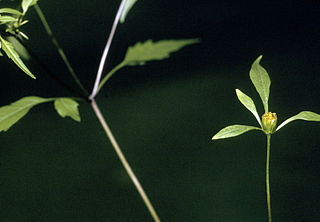
Asteraceae is a large family of flowering plants that consists of over 32,000 known species in over 1,900 genera within the order Asterales. The number of species in Asteraceae is rivaled only by the Orchidaceae, and which is the larger family is unclear as the quantity of extant species in each family is unknown. The Asteraceae were first described in the year 1740 and given the original name Compositae. The family is commonly known as the aster, daisy, composite, or sunflower family.

Bidens is a genus of flowering plants in the aster family, Asteraceae. The genus include roughly 230 species which are distributed worldwide. Despite their global distribution, the systematics and taxonomy of the genus has been described as complicated and unorganized. The common names beggarticks, black jack, burr marigolds, cobbler's pegs, Spanish needles, stickseeds, tickseeds and tickseed sunflowers refer to the fruits of the plants, most of which are bristly and barbed. The generic name refers to the same character; Bidens comes from the Latin bis ("two") and dens ("tooth").

Coreopsis is a genus of flowering plants in the family Asteraceae. Common names include calliopsis and tickseed, a name shared with various other plants.

Bidens tripartita is a common and widespread species of flowering plant in the sunflower family, Asteraceae, commonly known as three-lobe beggarticks, three-part beggarticks, leafy-bracted beggarticks or trifid bur-marigold. It is native to much of Eurasia, North Africa, and North America, with naturalized populations in Australia and on some Pacific Islands.

Bidens frondosa is a North American species of flowering plant in the aster family, Asteraceae. It is widespread across much of Canada, the United States, and Mexico It is known in many other parts of the world as an introduced species, including Europe, Asia, Morocco, and New Zealand. Its many common names include devil's beggarticks, devil's-pitchfork, devil's bootjack, sticktights, bur marigold, pitchfork weed, tickseed sunflower, leafy beggarticks, and common beggar-ticks.

Bidens pilosa is an annual species of herbaceous flowering plant in the daisy family Asteraceae. Its many common names include hitch hikers, black-jack, beggarticks, farmer's friends and Spanish needle, but most commonly referred to as cobblers pegs. It is native to the Americas but is widely distributed as an introduced species in other regions including Eurasia, Africa, Australia, South America and the Pacific Islands, and is classified as an invasive species in some regions of the world.

Coreopsis basalis, commonly known as the goldenmane tickseed, is a North American plant species in the sunflower family. It is native to the southeastern and south-central United States from Texas to the Carolinas. Isolated populations have been reported from Connecticut, Illinois, and California.

Coreopsis nudata, the Georgia tickseed, is a herbaceous perennial plant species of the genus Coreopsis in the family Asteraceae. It is native to the southeastern United States, in the states of Georgia, Florida, Alabama, Mississippi, and Louisiana.

Bidens laevis is a species of flowering plant in the daisy family known by the common names larger bur-marigold and smooth beggarticks. It is native to South America, Mexico, and the southern and eastern United States. It grows in wetlands, including estuaries and riverbanks.

Bidens vulgata is a species of flowering plant in the family Asteraceae known by the common names big devils beggarticks and tall beggarticks. It is native to eastern and central North America from Nova Scotia to northern Georgia and as far west as the Rocky Mountains. It is an introduced species on the West Coast of North America as well as parts of Europe.

Bidens beckii, commonly called Beck's water-marigold or simply water marigold is a species of flowering plant in the family Asteraceae. It is native to Canada and the northern United States.

Bidens bidentoides, commonly called swamp beggar's-ticks and delmarva beggarticks, is an annual, herbaceous, flowering plant in the Asteraceae family. It is native to the northeastern and east-central parts of the United States, the coastal plain of the States of Maryland, Delaware, Pennsylvania, and New Jersey plus the region around the Hudson River estuary in New York.

Bidens bigelovii, commonly called Bigelow's beggarticks, is an annual herbaceous flowering plant in the Asteraceae family. It is native to the southwestern and south-central United States and as far south as Oaxaca, Mexico.

Bidens connata , the purplestem beggarticks or London bur-marigold, is a species of flowering plant in the family Asteraceae. It is widespread across much of Eurasia, North Africa, and North America, and naturalized in Australia and on certain Pacific Islands.

Bidens discoidea, commonly known as small beggarticks, is an annual, herbaceous, flowering plant in the Asteraceae family. It is widespread across eastern Canada and the eastern and central United States, from Nova Scotia west to Minnesota, south to Florida and Texas.
Bidens heterosperma, commonly known as the Rocky Mountain beggarticks, is an annual or perennial, herbaceous, flowering plant in the family Asteraceae, tribe Coreopsideae. It is native to northwestern and north-central Mexico, and portions of the southwestern United States.

Bidens hyperborea is a variable species of flowering plant in the family Asteraceae, known from estuarine regions in northeastern North America. It is similar to Bidens cernua, Bidens laevis, and Bidens eatonii. B. hyperborea is listed as an endangered species in the state of Massachusetts, where it is threatened by habitat degradation, and is listed by NatureServe as critically imperiled (S1) in the province of Ontario and possibly extirpated from New Hampshire.
Bidens leptocephala, commonly known as the fewflower beggarticks, is an annual herbaceous flowering plant in the Asteraceae family. It is native to the southwestern United States and northern Mexico.


















